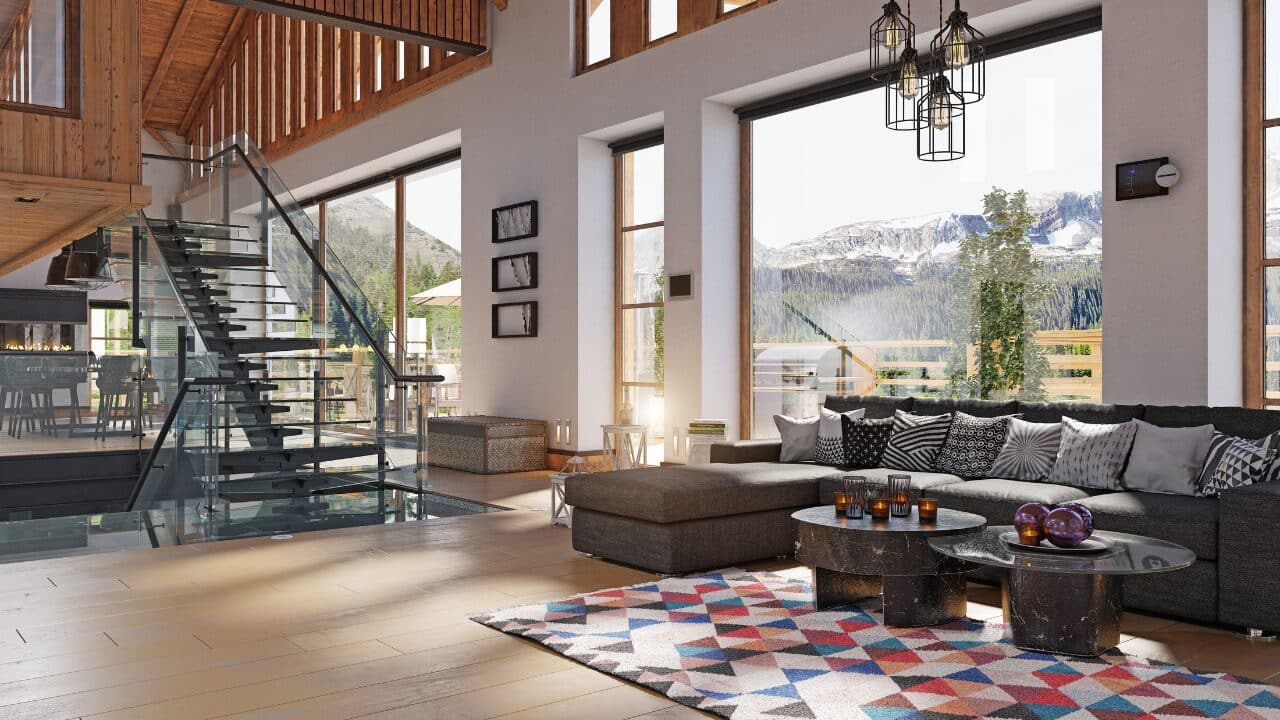Table of Contents
Unveiling the New Era of Real Estate with 3D Rendering
Integrating 3D rendering for real estate has ushered in a transformative era in property marketing, marking a significant leap from traditional methodologies. This article aims to dissect the profound impact and advantages of 3D rendering technologies in revolutionizing real estate marketing. At the core of this revolution lies the ability of 3D rendering to create vivid, detailed, and immersive property visualizations that were once impossible.
We delve into the specifics of how 3D rendering enhances the representation of properties, enriches client engagement, and ultimately reshapes the marketing strategies in real estate. From virtual tours to photorealistic representations, this exploration will provide an in-depth understanding of the technological advances driving this change and the tangible benefits they bring to the real estate industry.
Benefits of 3D Rendering for Real Estate Marketing
Enhanced Property Visualization and Buyer Engagement
3D rendering has profoundly impacted real estate marketing by enhancing property visualization and buyer engagement. In an industry where visual representation is crucial, the ability to present properties in a three-dimensional format has been a game-changer.
Unlike traditional 2D images, 3D renders allow potential buyers to visualize the property more realistically, providing a clearer understanding of its dimensions, layout, and potential. This is particularly crucial in the pre-construction phase, where 3D renders are the only visual cue for buyers to gauge the final product.
According to a study by the National Association of Realtors, 82% of buyers find online property images extremely useful, and with 3D renders, these images become exponentially more impactful.
For instance, real estate agents using 3D renders report up to a 60% increase in email inquiries, and properties with 3D tours receive 49% more qualified leads. The immersive experience of a 3D render engages clients more effectively, allowing them to visualize themselves in the space, which is a powerful motivator in the decision-making process.
Accuracy and Informed Decision-Making in Design
The accuracy of 3D rendering also plays a crucial role in facilitating informed decision-making for buyers and developers. Detailed 3D models help identify design flaws or potential improvements early in the design process, saving costs and time. It gives buyers a detailed preview of the property, including insights into sunlight patterns, room sizes, and spatial relationships, leading to more informed purchasing decisions.
For developers and real estate agents, the precision of 3D renders means they can market properties more confidently, ensuring what is presented is a realistic representation of the final product.
This accuracy builds client trust and can significantly reduce discrepancies between client expectations and the actual property. In the luxury real estate market, where customization and detail are paramount, 3D renders have become indispensable for showcasing the high-end features and customizations available.
Facilitating Pre-Sales and Market Adaptability
The real estate market is increasingly competitive, and the ability to pre-sell properties before construction completion is crucial for cash flow and funding. 3D rendering has become vital in this aspect, especially in the residential sector.
Developers can secure sales much earlier in the construction process by providing potential buyers with a realistic visualization of the final product. This is not limited to residential real estate; commercial properties also benefit from 3D rendering, allowing businesses to plan their spaces ahead of construction.
The adaptability that 3D rendering offers in terms of changes to design and features is another significant advantage. If market trends shift or client feedback indicates a need for change, 3D renders can be easily modified to reflect these changes, ensuring that the marketing materials are always aligned with current market demands and client preferences.
3D Rendering Techniques in Real Estate
Diverse Techniques for Enhanced Real Estate Visualization
The realm of 3D rendering in real estate encompasses a variety of techniques, each catering to different aspects of property marketing. Photorealistic renders stand out for accurately depicting properties, capturing the textures, colors, and interplay of light and shadow in great detail.
This technique is invaluable in marketing high-end residential and commercial properties, where visual appeal can significantly influence buyer decisions. In 2019, a survey by CGarchitect revealed that 85% of the real estate companies using 3D visualization tools opted for photorealistic rendering due to its impact on client engagement.
Virtual staging is another popular technique that is instrumental in the residential market. It involves furnishing an empty property digitally, offering potential buyers a glimpse into the furnished interiors. This approach not only enhances the aesthetic appeal of the property but also helps buyers visualize the potential of the space.
According to the National Association of Realtors, 77% of real estate agents believe staging a home makes it easier for a buyer to visualize the property as a future home.
Aerial rendering provides a bird’s-eye view of the property and its surroundings and is particularly effective in large-scale projects. It gives buyers a comprehensive overview of the property’s layout, infrastructure, and relation to the surrounding area.
This is crucial for developments like gated communities, industrial complexes, and large commercial zones, where the property’s context and location are major selling points.
Application and Impact of Various Rendering Techniques
Each rendering technique serves a specific purpose in real estate marketing. Photorealistic renders are often used in brochures, digital campaigns, and billboards, giving prospective buyers a tangible feel of the property.
Virtual staging, on the other hand, is predominantly used in online listings, where it increases the property’s appeal and can significantly reduce the time a property spends on the market. For instance, a study by the Real Estate Staging Association found that staged homes sold 73% faster than those not.
Aerial rendering finds its application in online and offline marketing materials, offering a unique perspective that ground-level photography cannot. It is particularly effective in showcasing the advantages of a property’s location, proximity to amenities, and overall layout concerning its environment.
Case Studies: Successful Real Estate Projects Using 3D Rendering
Analyzing the Impact of 3D Rendering on Real Estate Success
The efficacy of 3D rendering in real estate marketing is best illustrated through real-life case studies. One notable example is the Hudson Yards project in New York City. Before its completion, the developers used extensive 3D renderings to market this massive mixed-use development.
These renderings played a crucial role in attracting both commercial tenants and residential buyers by providing a realistic view of the project, including its retail spaces, public areas, and residential units. As a result, a significant portion of the commercial and residential spaces was leased or sold before the project’s completion.
Another successful application of 3D rendering was marketing the ‘One57’ skyscraper in Manhattan. The developers used high-quality 3D renderings to sell this luxury residential building, offering potential buyers a glimpse into the city’s opulent interiors and stunning views. The renderings were instrumental in achieving record-breaking sales, with one of the penthouses selling for over $100 million.
Insights into 3D Rendering Contributions to Project Success
These case studies demonstrate that 3D rendering can significantly enhance the marketability of real estate projects.
By providing potential buyers and tenants with a realistic preview of the property, developers and real estate agents can create a sense of excitement and anticipation, driving interest and sales. The Hudson Yards project, for instance, utilized 3D renderings not just to show the final product but to convey the development’s vision and scale, which was crucial in attracting high-profile commercial tenants.
In residential projects like One57, 3D rendering in marketing materials allowed for a much higher emotional engagement with potential buyers. By showcasing the luxurious interiors and panoramic views in photo realisticphotorealistic detail, the developers could command premium prices for the units.
Challenges and Considerations in Implementing 3D Rendering
Navigating the Complexities of 3D Rendering Adoption
Despite the myriad benefits, incorporating 3D rendering into real estate marketing strategies takes time and effort. One of the primary obstacles is the cost and time investment required to produce high-quality renders. Creating detailed and accurate 3D models can be resource-intensive, requiring skilled professionals and sophisticated software.
This can pose a significant barrier for smaller real estate firms or individual agents. According to a report by the American Institute of Architects, the initial cost of 3D rendering software and the training required to use it effectively can be substantial, often deterring smaller practices from adopting it.
Another challenge lies in keeping up with rapidly evolving rendering technologies. Staying abreast of the latest tools and techniques is crucial for maintaining a competitive edge, but it can also be overwhelming, especially for professionals who need to be tech-savvy.
The fast-paced evolution of software and hardware means that what is cutting-edge today may become obsolete in a few short years, necessitating continuous investment in technology and skills development.
Best Practices for Effective Integration
To effectively integrate 3D rendering into real estate marketing, balancing cost with quality is essential. One strategy is to use 3D rendering selectively for high-value properties or critical projects where the visual impact can justify the investment.
Outsourcing to specialized 3D rendering firms can also be a cost-effective solution, especially for smaller agencies that need help to afford in-house expertise.
Additionally, it’s essential to focus on training and skill development. Encouraging staff to stay informed about the latest rendering technologies and techniques can enhance the quality of renders and the efficiency of the design process.
Collaborating with architectural firms and designers with expertise in 3D rendering can also provide valuable insights and help real estate professionals understand the full potential of these technologies.
The Future of 3D Rendering in Real Estate Marketing
Anticipating Trends and Technological Advancements
The future of 3D rendering in real estate marketing looks promising, with several trends and technological advancements on the horizon. One significant development is the increasing integration of virtual and augmented reality (VR and AR) with 3D rendering. This integration will enable even more immersive and interactive property viewings.
For instance, AR apps allow potential buyers to visualize a property in different styles or settings directly from their smartphones or tablets. The Global Augmented Reality and Virtual Reality Market in the Real Estate Industry report predicts a growth rate of approximately 25% in the AR and VR market within real estate between 2019 and 2025, indicating a significant shift towards these technologies.
Another emerging trend is using artificial intelligence (AI) in rendering processes. AI algorithms can automate certain aspects of the rendering process, such as optimizing lighting and textures based on the environment, thereby reducing the time and effort required to create high-quality renders. This could make 3D rendering more accessible and cost-effective, especially for smaller real estate entities.
Shaping the Future of Property Marketing
As these technologies continue to evolve, they will undoubtedly reshape the real estate marketing landscape. The enhanced realism and interactivity offered by advanced 3D rendering and VR/AR technologies will set new standards in property visualization, making it a critical component of real estate marketing strategies.
This shift will benefit high-end properties and become increasingly relevant for mid-range and even budget properties as the technology becomes more widespread and cost-effective.
In conclusion, the potential of 3D rendering in real estate marketing is vast and still unfolding. As we move forward, this technology is set to play an even more integral role in how properties are marketed and sold, offering unprecedented opportunities for engagement, customization, and immersive experiences.
Real estate professionals who embrace these changes and adapt to the evolving technological landscape will be well-positioned to succeed in this dynamic market.





